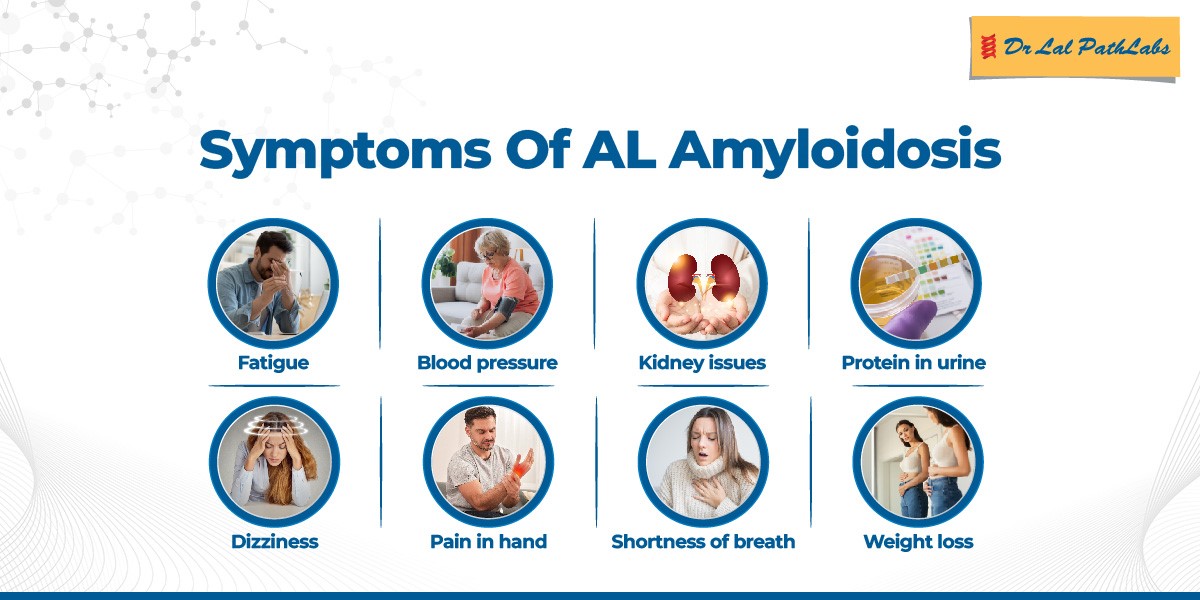Amyloidosis – Symptoms & Causes
Amyloid is an abnormal protein found in the bone marrow that can deposit in any organ or tissue of the body. When this protein starts building up in the organs, it leads to a rare condition known as amyloidosis. Different types of amyloidosis require different types of treatment.
What is amyloidosis?
Amyloidosis is a rare disease that occurs when an abnormal protein known as amyloid builds up in organs and tissues throughout the body.
Amyloid deposits are typically made of misfolded proteins aggregating into long, rigid fibres. These deposits can build up in the nervous system, heart, liver, kidney, and digestive tract. Amyloidosis can be localised to one area or can be widespread.
The severity of amyloidosis largely depends on the organs affected and the amount of amyloid accumulated.
What are the causes of amyloidosis?
Depending on the precursor protein, amyloidosis is classified into several types. Further, the different types of amyloidosis are classified as localised or systemic. In the former, abnormal protein is restricted to one organ; in the latter, it is deposited throughout a person’s body.
Here are the most common amyloidosis causes and the types that can arise:
- AL (primary) Amyloidosis: It is a plasma cell disorder. Plasma cells create antibodies that fight infections. It includes immunoglobulin proteins made of light and heavy protein chains. In AL amyloidosis, plasma cells produce abnormal light protein chains, resulting in their misfolding and clumping together. It then takes the form of amyloid fibrils that deposit in a person’s organs. The heart, kidneys, and nervous system are the most common organs affected by AL amyloidosis.
- ATTR Amyloidosis: The liver produces a protein called transthyretin (TRR). It carries thyroid hormone and Vitamin A in our blood. When this protein breaks apart, it creates fibrils in a person’s organs. This form primarily affects the heart and nerves. ATTR amyloidosis may be passed down in families.
- AA (secondary) Amyloidosis: A person’s body produces a protein called ‘serum amyloid A’ in response to inflammation or infection in one’s body. Diseases leading to chronic inflammation and infection can result in AA amyloidosis deposits over time. Some of them include tuberculosis, rheumatoid arthritis or periodic fevers. The most commonly affected organ in AA amyloidosis is the kidney.
What are the Symptoms of amyloidosis?
The amyloidosis symptoms differ depending on the type of amyloidosis and affected organs. Some common symptoms include:
- Shortness of breath
- Increased tongue size
- Unexpected weight loss
- Swelling in legs, ankles, belly, or feet
- Pins and needles or numbness in hands or feet
- Fatigue
- An enlarged spleen or liver
- An irregular heartbeat
- Bleeding more than usual after an injury
- Recurrent infections
- Changes in the skin, such as easy bruising or thickening and a purple patch around the eyes
How is amyloidosis diagnosed?
Early detection of amyloidosis can prevent organ damage. Also, precise diagnosis is critical as the treatment varies greatly depending on the patient’s condition. That’s why your doctor may conduct a physical examination and ask about your symptoms and medical history to determine the best diagnostic approach.
For amyloidosis diagnosis, a doctor may recommend the following.
-
Blood and urine test
Through blood and urine tests, you can check the amyloid protein levels. It can also help you in checking liver and thyroid function.
-
Biopsy
While other tests can indicate the presence of amyloid proteins, only a biopsy can provide a definitive diagnosis. It involves taking a small tissue sample for examination under a microscope. Tissue samples are usually taken from abdominal fat or bone marrow. Sometimes, samples may also be taken from affected organs like the liver, nerves, heart, kidneys, or rectum.
-
Imaging tests
Imaging tests are an essential part of amyloidosis diagnosis. They help doctors visualise the affected organs and detect any abnormalities caused by the build-up of amyloid proteins. Some standard imaging tests used in amyloidosis diagnosis include:
- Echocardiogram (ECG)
- Magnetic Resonance Imaging (MRI)
- Nuclear Medicine Scans
How is amyloidosis treated?
Amyloidosis is not curable. However, the treatments available will help manage the symptoms and slow down the production of amyloid protein. Amyloidosis treatment includes:
-
Chemotherapy
For some people with primary AL amyloidosis, high-dose chemotherapy and a stem cell transplant can effectively remove the harmful substance that causes amyloid formation. However, chemotherapy medicines alone can be used as a treatment in other cases of primary AL amyloidosis.
-
Organ transplant
In some instances, where amyloid deposits have severely damaged the organs, such as the kidney, liver or heart, a person may undergo organ transplant surgery.
-
Dialysis
It is a procedure used for amyloidosis when it affects the kidneys. It helps support kidney function by filtering waste and excess fluids from the blood.
-
Medications
Treatments that manage symptoms and support organ function can be diuretics to reduce fluid build-up or pain relievers for discomfort. Some general treatment also involves blood thinners to prevent blood clots and medications to control your heart rate.
Depending on the type of amyloidosis, the patient may require multiple types of treatments.
Conclusion
Amyloidosis is a rare and incurable disease. However, using diagnostic tools can help in the early detection of the disease, which, in turn, can help prevent further organ damage. Based on this early diagnosis, prompt treatment can be administered, offering some relief from discomfort.














